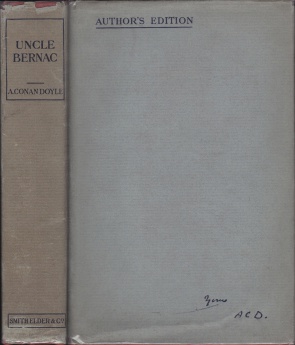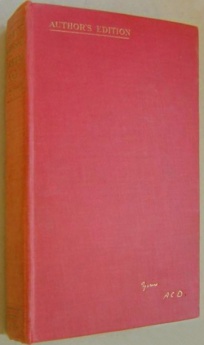Arthur Conan Doyle Author's Edition

The Arthur Conan Doyle Author's Edition is a series of:
- 13 volumes published in USA by D. Appleton & Co. (1903)
- 12 volumes published in UK by Smith, Elder & Co. (1903) and John Murray (reissued in 1917 but still marked 1903)
Collecting Arthur Conan Doyle's stories written between 1891 and 1903. The 13 volumes hold 12 novels and 5 collected series (61 short stories).
US edition (D. Appleton & Co.) have only 1 frontispiece in each volume.
Stories

List sorted by Smith, Elder & Co.:
- 24.09.1903 : Vol. 01 : Preface, The White Company (2 illustrations by Arthur Twidle)
- 24.09.1903 : Vol. 02 : Micah Clarke (2 ill. by Arthur Twidle)
- 24.09.1903 : Vol. 03 : The Refugees (2 ill. by Arthur Twidle)
- 24.09.1903 : Vol. 04 : Rodney Stone (2 ill. by Arthur Twidle)
- 15.10.1903 : Vol. 05 : Adventures of Sherlock Holmes (2 ill. by Arthur Twidle)
- 15.10.1903 : Vol. 06 : The Memoirs of Sherlock Holmes (2 ill. by Arthur Twidle)
- 15.10.1903 : Vol. 07 : A Study in Scarlet and The Sign of Four (2 ill. by Arthur Twidle)
- Note to this Edition (1893's note by Ward, Lock & Bowden)
- Mr. Sherlock Holmes, by Dr. Joseph Bell
- A Study in Scarlet
- The Sign of Four
- 15.10.1903 : Vol. 08 : Preface, The Great Shadow and Uncle Bernac (2 ill. by Arthur Twidle)
- 16.11.1903 : Vol. 09 : Preface, A Duet, with an Occasional Chorus (2 ill. by Arthur Twidle)
- 16.11.1903 : Vol. 10 : Preface, Tragedy of the Korosko and The Green Flag (1 ill. by Sidney Paget and 1 by Arthur Twidle)
- 16.11.1903 : Vol. 11 : Preface, The Stark Munro Letters and Round the Red Lamp (1 ill. by B. West Clinedinst and 1 by Arthur Twidle)
- 16.11.1903 : Vol. 12 : Preface, The Exploits of Brigadier Gerard (2 ill. by W. B. Wollen)
in US edition only
- Volume 13 : The Hound of the Baskervilles (2 ill. by Sidney Paget)
Editions
- Author's Edition (24 september - 16 november 1903, Smith, Elder & Co. [UK]) 12 volumes
- Author's Edition (24 september 1903, D. Appleton & Co. [US]) 13 volumes
- Author's Edition (1917, John Murray [UK]) 12 volumes
- with dustjacket
- without dustjacket
Preface
Published in volume 1 "The White Company" (Smith, Elder & Co., 1903).
PREFACE TO THE AUTHOR'S EDITION
It has always been my ambition — the dearer because it appeared to be unattainable — to have a collected edition of my own works. I have never, however, desired that that edition should be complete. On the contrary, the great charm of such a new departure was that it gave me an opportunity of finally casting off what my more mature judgment told me to be unworthy and of retaining what my conscience approved. That there should remain some twelve good-sized volumes will prove to some of my readers that that conscience is fairly elastic. For better, for worse, I have expended all pains in putting these books into their final form, and so I leave them. Outside this edition there is no work of mine up to this date which I do not willingly suppress.
For the help of any critic who may desire a clew as to a possible classification of these volumes, which deal in many ways with many subjects, I may suggest how they divide themselves in my own mind. There are, in the first place, the historical romances, which include "Micah Clarke," "The White Company," "The Great Shadow," "The Refugees," "Brigadier Gerard," "Rodney Stone," and "Uncle Bernac," together with what I may describe as the contemporary historical romance of "The Tragedy of the Korosko" (published in America under the name of "A Desert Drama"). Though some are lighter and some are graver, these eight books are essentially similar in their method of treatment. They may themselves be subdivided into four which illustrate the Napoleonic era (two, "Rodney Stone" and "The Great Shadow," from the English, and two, "Uncle Bernac" and "Brigadier Gerard," from the French point of view), one mediaeval, one of England of the seventeenth century, and one of the French Court of Louis XI V. Then, on a different and humbler plane, come the police romances, "The Adventures of Sherlock Holmes," "The Memoirs of Sherlock Holmes," "A Study in Scarlet," and "The Sign of Four," to which will eventually be added "The Hound of the Baskervilles." Next come the medical stories, "Round the Red Lamp" and the "Stark Munro Letters." These make up the series with the exception of two volumes of collected tales, and "A Duet," the purpose of which I will treat in a later preface. In the case of each book I have added in this edition some small explanation as to the scope and object of the work. A preface had always seemed to me an unnecessary impertinence, until I found by experience how easily one may be misunderstood. I have altered some of the stories, shortened others, corrected all, and added some notes which may be of interest to the reader in the case of the historical romances.
And before I stand aside I am emboldened by the vision of this line of volumes to say a few words as to my own conception of the art of fiction. That conception is that our treatment may be as wide as the heavens and as broad as the earth, if it does but attain the essential end of interest. All methods and schools, romance and realism, symbolism and naturalism, have the one object in view — to interest. They are all good so far as they attain that, and all useless when they cease to do so. The weary workers or the more weary idlers turn to the writer and demand to have their thoughts drawn away from themselves and the routine of their own lives. Within the bounds of morality all methods are legitimate by which we can effect this. Every school is right in claiming that it is justified, and every school is wrong when it tries to prove that its rival is unjustified. You are right to make your book adventurous, you are right to make it theological, you are right to make it informative or controversial or idyllic, or humourous or grave or what you will, but you must make it interesting. 'That is essential — all the rest is detail. There is nothing inconsistent in the same writer using every method in turn, so long as he can in each hold his reader and take his thoughts from his own selfish interests.
But there comes the obvious retort, "You say 'interesting' — interesting to whom?" The difficulty is not really a great one. The higher and more permanent work has always been interesting to all. The work which is the cult of a clique, too precious for general use, must be wanting in some quality. We know cases where obscurity of style has retarded the recognition of really great writers — but obscurity of style is not a virtue, and they were great in spite of it. Take the most honoured names in our literature, Scott, Thackeray, Dickens, Reade, Poe, they do not interest one or other social stratum, but they appeal equally to all educated readers. If you were to make a list of the works of fiction which have proved their greatness by their permanence and by the common consensus of mankind, you would find that no narrow formula would cover them. "Tom Jones," "Don Quixote," "Gulliver's Travels," "Madame Bovary," "Esmond," "Pride and Prejudice," "Notre Dame," which shall we rule out as inartistic! And yet the only point which they have in common is that each of them holds the attention of the reader.
It is just this power of holding the attention which forms the art of story-telling — an art which may be developed and improved but cannot be initiated. It is the power of sympathy, the sense of the dramatic. There is no more capricious and indefinable quality. The professor in his study may have no trace of it, while the Irish nurse m the attic can draw out the very souls of his children with her words. It is imagination — and it is the power of conveying imagination. But we do not know what imagination is, and so all our definitions and explanations become mere juggling with words.
And still critics are found to write, "The book is interesting, but we confess that we are unable to say what useful purpose it serves." As if interest were not in itself the essential purpose! Ask the sleepless man worn with insomnia, the watcher beside the sick-bed, the man of business whose very sanity depends upon getting his thoughts out of one weary groove, the tired student, the woman whose only escape from an endless sordid life is that one window of imagination which leads out into the enchanted country — ask all these if interest serves any useful purpose. The life of a writer of fiction has its own troubles, the weary waiting for ideas, the blank reaction when they have been used, worst of all the despair when the thought which had seemed so bright and new goes dull and dark in the telling. But surely he has in return some claim to hope that if he can but interest his readers he fulfils the chief end of man in leaving others a little happier than he found them.
- A. CONAN DOYLE.
- UNDERSHAW, HINDHEAD.


